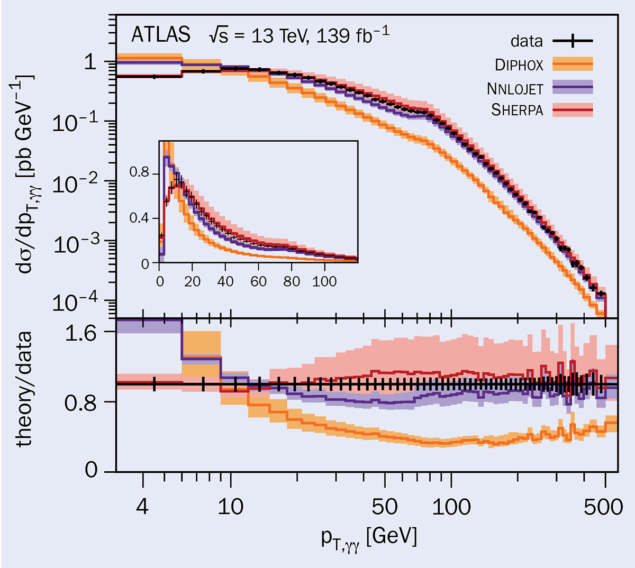A report from the ATLAS experiment

Most processes resulting from proton–proton collisions at the LHC are affected by the strong force – a difficult-to-model part of the Standard Model involving non-perturbative effects. This can be problematic when measuring rare processes not mediated by strong interactions, such as those involving the Higgs boson, and when searching for new particles or interactions. To ensure such processes are not obscured, precise knowledge of the more dominant strong-interaction effects, including those caused by the initial-state partons, is a prerequisite to LHC physics analyses.
The electromagnetic production of a photon pair is the dominant background to the H → γγ decay channel – a process that is instrumental to the study of the Higgs boson. Despite its electromagnetic nature, diphoton production is affected by surprisingly large strong-interaction effects. Thanks to precise ATLAS measurements of diphoton processes using the full Run-2 dataset, the collaboration is able to probe these effects and scrutinise state-of-the-art theoretical calculations.
Measurements studying strong interactions typically employ final states that include jets produced from the showering and hadronisation of quarks and gluons. However, the latest ATLAS analysis instead uses photons, which can be very precisely measured by the detector. Although photons do not carry a colour charge, they interact with quarks as the latter carry electric charge. As a result, strong-interaction effects on the quarks can alter the characteristics of the measured photons. The conservation of momentum allows us to quantify this effect: the LHC’s proton beams collide head-on, so the net momentum transverse to the beam axis must be zero for the final-state particles. Any signs to the contrary indicate additional activity in the event with equivalent but opposite transverse momentum, usually arising from quarks and gluons radiated from the initial-state partons. Therefore, by measuring the transverse momentum of photon pairs, and related observables, the strong interaction may be indirectly probed.
A surprising role of the strong interaction in electro-magnetic diphoton production is revealed
Comparing the measured values to predictions reveals the surprising role of the strong interaction in electromagnetic diphoton production. In a simple picture without the strong interaction, the momentum of each photon should perfectly balance in the transverse plane. However, this simplistic expectation does not match the measurements (see figure 1). Measuring the differential cross-section as a function of the transverse momentum of the photon pair, ATLAS finds that most of the measured photon pairs (black points) have low but non-zero transverse momenta, with a peak at approximately 10 GeV, followed by a smoothly falling distribution towards higher values.
Extending calculations to encompass next-to-next-to-leading order corrections in the strong-interaction coupling constant (purple line), the impact of the strong interaction becomes manifest. The measured values at high transverse momenta are well described by these predictions, including the bump observed at 70 GeV, which is another manifestation of higher-order strong-interaction effects. Monte Carlo event generators like Sherpa (red line), which combine similar calculations with approximate simulations of arbitrarily many-quark and gluon emissions – especially relevant at low energies – properly describe the entire measured distribution.
The results of this analysis, which also include measurements of other distributions such as angular variables between the two photons, don’t just viscerally probe the strong interaction – they also provide a benchmark for this important background process.
Further reading
ATLAS Collab. 2021 arXiv:2107.09330.





